Abstract
Protamines are small arginine-rich proteins that package DNA in spermatozoa. The mouse protamine 1 (Prm-1) gene is transcribed exclusively in post-meiotic spermatids. To identify elements in the Prm-1 promoter required for spermatid-specific transcription, we generated transgenic mice by microinjection of transgenes containing Prm-1 5' flanking sequences with 5' truncations or internal deletions of conserved sequences linked to a marked Prm-1 gene. We also tested Prm-1 promoter regions with a heterologous human growth hormone reporter gene. We conclude that a 113-bp region can direct spermatid-specific transcription and we have defined sequences within this region that are essential for proper function. These results will facilitate the isolation and characterization of transcription factors essential for post-meiotic gene expression.
Full text
PDF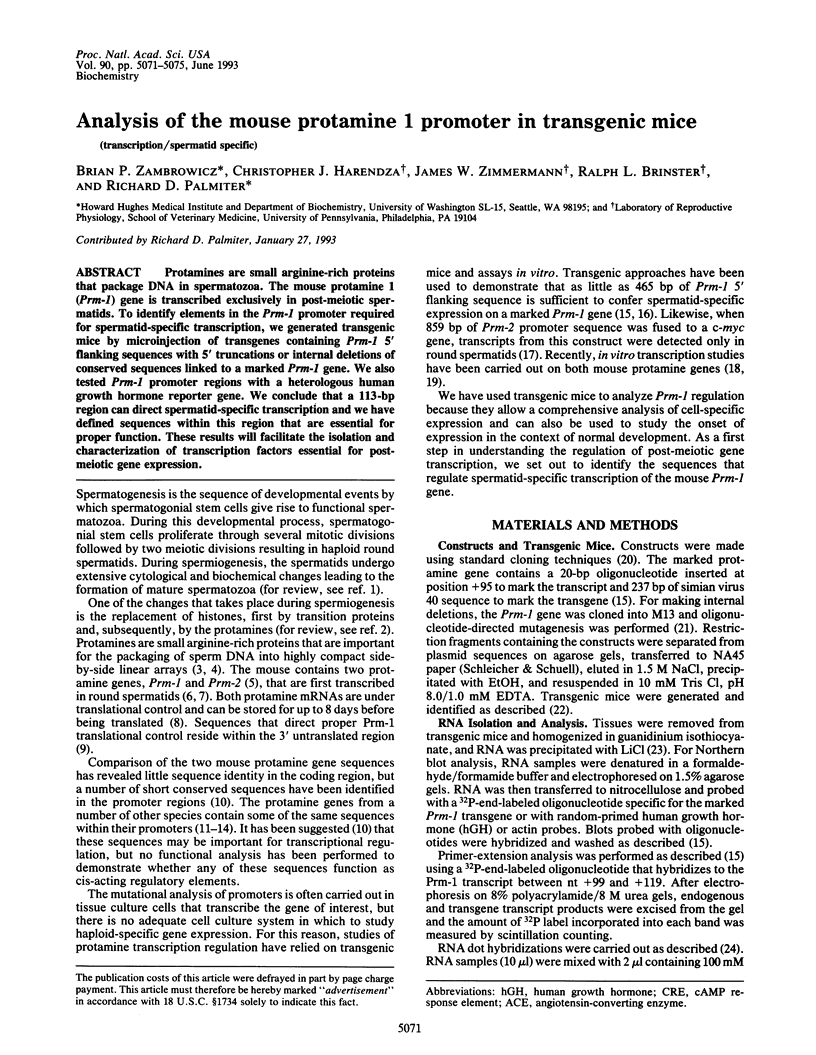
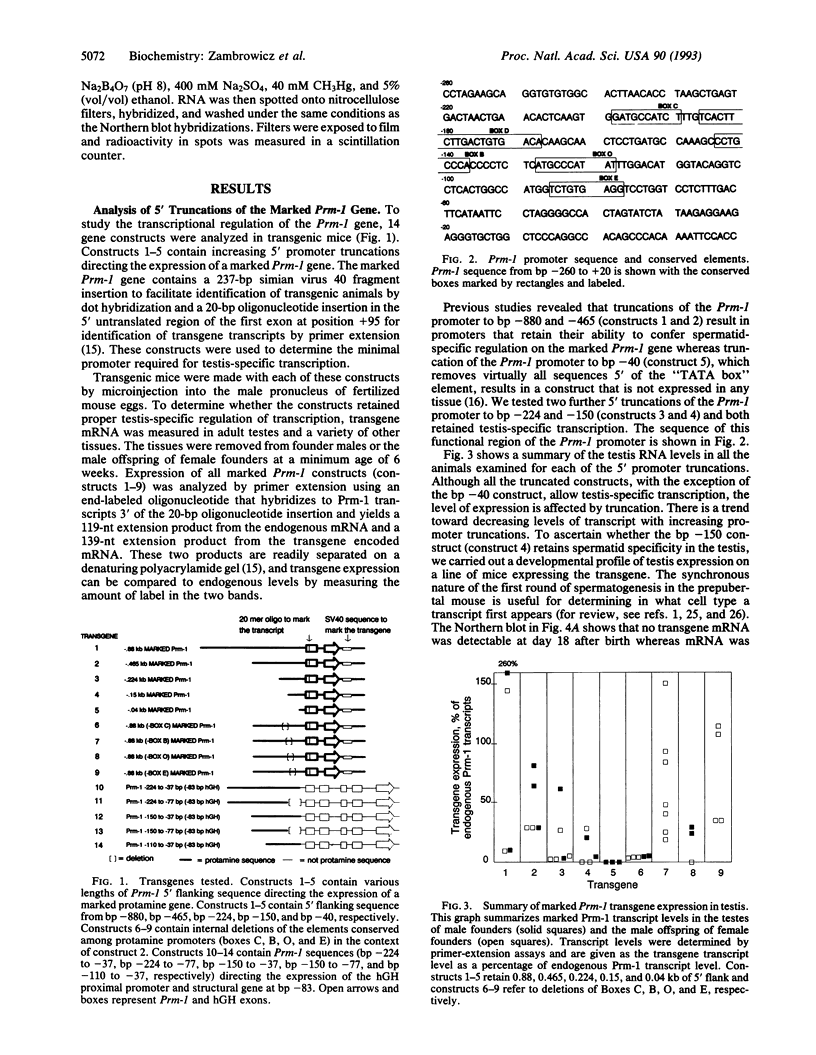
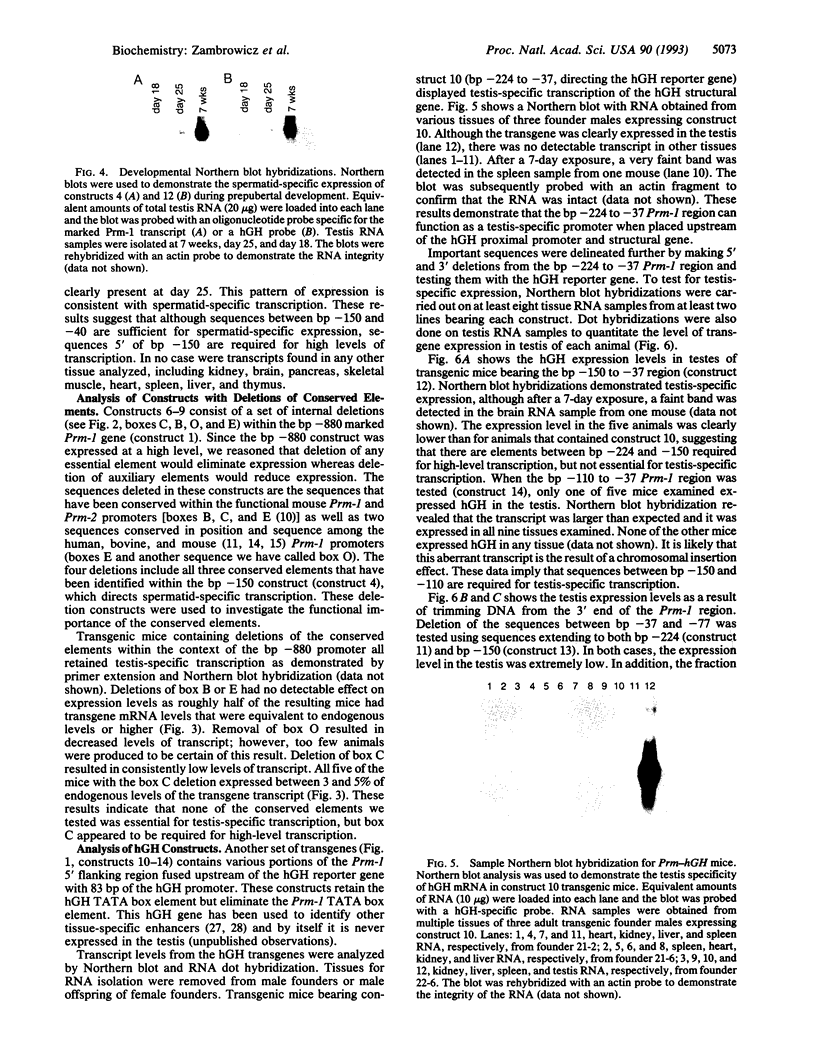
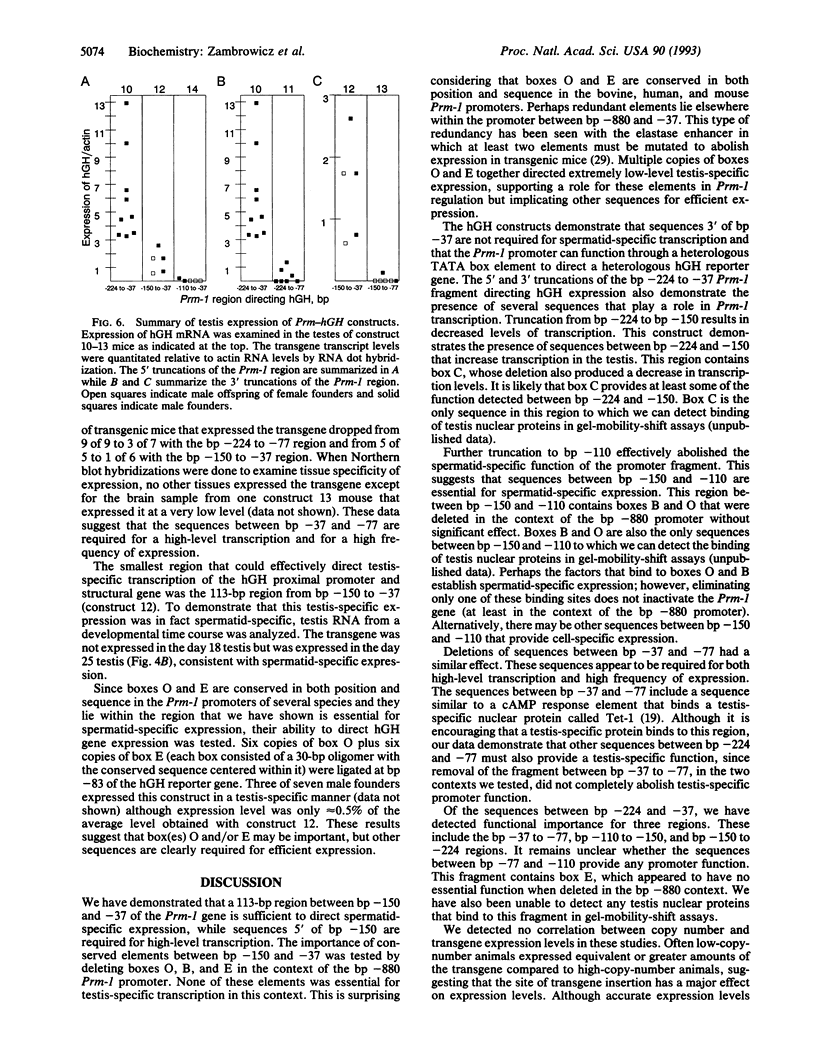
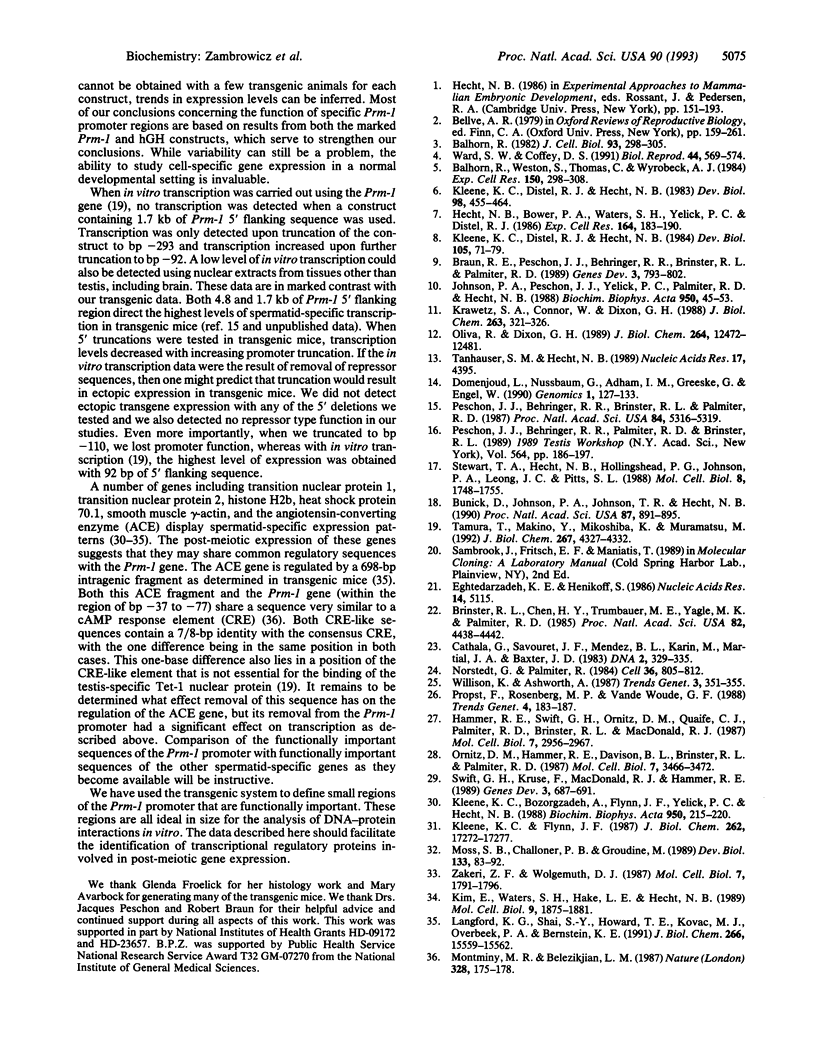
Images in this article
Selected References
These references are in PubMed. This may not be the complete list of references from this article.
- Balhorn R. A model for the structure of chromatin in mammalian sperm. J Cell Biol. 1982 May;93(2):298–305. doi: 10.1083/jcb.93.2.298. [DOI] [PMC free article] [PubMed] [Google Scholar]
- Balhorn R., Weston S., Thomas C., Wyrobek A. J. DNA packaging in mouse spermatids. Synthesis of protamine variants and four transition proteins. Exp Cell Res. 1984 Feb;150(2):298–308. doi: 10.1016/0014-4827(84)90572-x. [DOI] [PubMed] [Google Scholar]
- Braun R. E., Peschon J. J., Behringer R. R., Brinster R. L., Palmiter R. D. Protamine 3'-untranslated sequences regulate temporal translational control and subcellular localization of growth hormone in spermatids of transgenic mice. Genes Dev. 1989 Jun;3(6):793–802. doi: 10.1101/gad.3.6.793. [DOI] [PubMed] [Google Scholar]
- Brinster R. L., Chen H. Y., Trumbauer M. E., Yagle M. K., Palmiter R. D. Factors affecting the efficiency of introducing foreign DNA into mice by microinjecting eggs. Proc Natl Acad Sci U S A. 1985 Jul;82(13):4438–4442. doi: 10.1073/pnas.82.13.4438. [DOI] [PMC free article] [PubMed] [Google Scholar]
- Bunick D., Johnson P. A., Johnson T. R., Hecht N. B. Transcription of the testis-specific mouse protamine 2 gene in a homologous in vitro transcription system. Proc Natl Acad Sci U S A. 1990 Feb;87(3):891–895. doi: 10.1073/pnas.87.3.891. [DOI] [PMC free article] [PubMed] [Google Scholar]
- Cathala G., Savouret J. F., Mendez B., West B. L., Karin M., Martial J. A., Baxter J. D. A method for isolation of intact, translationally active ribonucleic acid. DNA. 1983;2(4):329–335. doi: 10.1089/dna.1983.2.329. [DOI] [PubMed] [Google Scholar]
- Domenjoud L., Nussbaum G., Adham I. M., Greeske G., Engel W. Genomic sequences of human protamines whose genes, PRM1 and PRM2, are clustered. Genomics. 1990 Sep;8(1):127–133. doi: 10.1016/0888-7543(90)90234-l. [DOI] [PubMed] [Google Scholar]
- Eghtedarzadeh M. K., Henikoff S. Use of oligonucleotides to generate large deletions. Nucleic Acids Res. 1986 Jun 25;14(12):5115–5115. doi: 10.1093/nar/14.12.5115. [DOI] [PMC free article] [PubMed] [Google Scholar]
- Hammer R. E., Swift G. H., Ornitz D. M., Quaife C. J., Palmiter R. D., Brinster R. L., MacDonald R. J. The rat elastase I regulatory element is an enhancer that directs correct cell specificity and developmental onset of expression in transgenic mice. Mol Cell Biol. 1987 Aug;7(8):2956–2967. doi: 10.1128/mcb.7.8.2956. [DOI] [PMC free article] [PubMed] [Google Scholar]
- Hecht N. B., Bower P. A., Waters S. H., Yelick P. C., Distel R. J. Evidence for haploid expression of mouse testicular genes. Exp Cell Res. 1986 May;164(1):183–190. doi: 10.1016/0014-4827(86)90465-9. [DOI] [PubMed] [Google Scholar]
- Johnson P. A., Peschon J. J., Yelick P. C., Palmiter R. D., Hecht N. B. Sequence homologies in the mouse protamine 1 and 2 genes. Biochim Biophys Acta. 1988 May 6;950(1):45–53. doi: 10.1016/0167-4781(88)90071-1. [DOI] [PubMed] [Google Scholar]
- Kim E., Waters S. H., Hake L. E., Hecht N. B. Identification and developmental expression of a smooth-muscle gamma-actin in postmeiotic male germ cells of mice. Mol Cell Biol. 1989 May;9(5):1875–1881. doi: 10.1128/mcb.9.5.1875. [DOI] [PMC free article] [PubMed] [Google Scholar]
- Kleene K. C., Borzorgzadeh A., Flynn J. F., Yelick P. C., Hecht N. B. Nucleotide sequence of a cDNA clone encoding mouse transition protein 1. Biochim Biophys Acta. 1988 Jul 13;950(2):215–220. doi: 10.1016/0167-4781(88)90013-9. [DOI] [PubMed] [Google Scholar]
- Kleene K. C., Distel R. J., Hecht N. B. Translational regulation and deadenylation of a protamine mRNA during spermiogenesis in the mouse. Dev Biol. 1984 Sep;105(1):71–79. doi: 10.1016/0012-1606(84)90262-8. [DOI] [PubMed] [Google Scholar]
- Kleene K. C., Distel R. J., Hecht N. B. cDNA clones encoding cytoplasmic poly(A)+ RNAs which first appear at detectable levels in haploid phases of spermatogenesis in the mouse. Dev Biol. 1983 Aug;98(2):455–464. doi: 10.1016/0012-1606(83)90375-5. [DOI] [PubMed] [Google Scholar]
- Kleene K. C., Flynn J. F. Characterization of a cDNA clone encoding a basic protein, TP2, involved in chromatin condensation during spermiogenesis in the mouse. J Biol Chem. 1987 Dec 25;262(36):17272–17277. [PubMed] [Google Scholar]
- Krawetz S. A., Connor W., Dixon G. H. Bovine protamine genes contain a single intron. The structures of the two alleles. J Biol Chem. 1988 Jan 5;263(1):321–326. [PubMed] [Google Scholar]
- Langford K. G., Shai S. Y., Howard T. E., Kovac M. J., Overbeek P. A., Bernstein K. E. Transgenic mice demonstrate a testis-specific promoter for angiotensin-converting enzyme. J Biol Chem. 1991 Aug 25;266(24):15559–15562. [PubMed] [Google Scholar]
- Montminy M. R., Bilezikjian L. M. Binding of a nuclear protein to the cyclic-AMP response element of the somatostatin gene. Nature. 1987 Jul 9;328(6126):175–178. doi: 10.1038/328175a0. [DOI] [PubMed] [Google Scholar]
- Moss S. B., Challoner P. B., Groudine M. Expression of a novel histone 2B during mouse spermiogenesis. Dev Biol. 1989 May;133(1):83–92. doi: 10.1016/0012-1606(89)90299-6. [DOI] [PubMed] [Google Scholar]
- Norstedt G., Palmiter R. Secretory rhythm of growth hormone regulates sexual differentiation of mouse liver. Cell. 1984 Apr;36(4):805–812. doi: 10.1016/0092-8674(84)90030-8. [DOI] [PubMed] [Google Scholar]
- Oliva R., Dixon G. H. Chicken protamine genes are intronless. The complete genomic sequence and organization of the two loci. J Biol Chem. 1989 Jul 25;264(21):12472–12481. [PubMed] [Google Scholar]
- Ornitz D. M., Hammer R. E., Davison B. L., Brinster R. L., Palmiter R. D. Promoter and enhancer elements from the rat elastase I gene function independently of each other and of heterologous enhancers. Mol Cell Biol. 1987 Oct;7(10):3466–3472. doi: 10.1128/mcb.7.10.3466. [DOI] [PMC free article] [PubMed] [Google Scholar]
- Peschon J. J., Behringer R. R., Brinster R. L., Palmiter R. D. Spermatid-specific expression of protamine 1 in transgenic mice. Proc Natl Acad Sci U S A. 1987 Aug;84(15):5316–5319. doi: 10.1073/pnas.84.15.5316. [DOI] [PMC free article] [PubMed] [Google Scholar]
- Peschon J. J., Behringer R. R., Palmiter R. D., Brinster R. L. Expression of mouse protamine 1 genes in transgenic mice. Ann N Y Acad Sci. 1989;564:186–197. doi: 10.1111/j.1749-6632.1989.tb25897.x. [DOI] [PubMed] [Google Scholar]
- Propst F., Rosenberg M. P., Vande Woude G. F. Proto-oncogene expression in germ cell development. Trends Genet. 1988 Jul;4(7):183–187. doi: 10.1016/0168-9525(88)90073-x. [DOI] [PubMed] [Google Scholar]
- Stewart T. A., Hecht N. B., Hollingshead P. G., Johnson P. A., Leong J. A., Pitts S. L. Haploid-specific transcription of protamine-myc and protamine-T-antigen fusion genes in transgenic mice. Mol Cell Biol. 1988 Apr;8(4):1748–1755. doi: 10.1128/mcb.8.4.1748. [DOI] [PMC free article] [PubMed] [Google Scholar]
- Swift G. H., Kruse F., MacDonald R. J., Hammer R. E. Differential requirements for cell-specific elastase I enhancer domains in transfected cells and transgenic mice. Genes Dev. 1989 May;3(5):687–696. doi: 10.1101/gad.3.5.687. [DOI] [PubMed] [Google Scholar]
- Tamura T., Makino Y., Mikoshiba K., Muramatsu M. Demonstration of a testis-specific trans-acting factor Tet-1 in vitro that binds to the promoter of the mouse protamine 1 gene. J Biol Chem. 1992 Mar 5;267(7):4327–4332. [PubMed] [Google Scholar]
- Tanhauser S. M., Hecht N. B. Nucleotide sequence of the rat protamine 2 gene. Nucleic Acids Res. 1989 Jun 12;17(11):4395–4395. doi: 10.1093/nar/17.11.4395. [DOI] [PMC free article] [PubMed] [Google Scholar]
- Ward W. S., Coffey D. S. DNA packaging and organization in mammalian spermatozoa: comparison with somatic cells. Biol Reprod. 1991 Apr;44(4):569–574. doi: 10.1095/biolreprod44.4.569. [DOI] [PubMed] [Google Scholar]
- Zakeri Z. F., Wolgemuth D. J. Developmental-stage-specific expression of the hsp70 gene family during differentiation of the mammalian male germ line. Mol Cell Biol. 1987 May;7(5):1791–1796. doi: 10.1128/mcb.7.5.1791. [DOI] [PMC free article] [PubMed] [Google Scholar]




